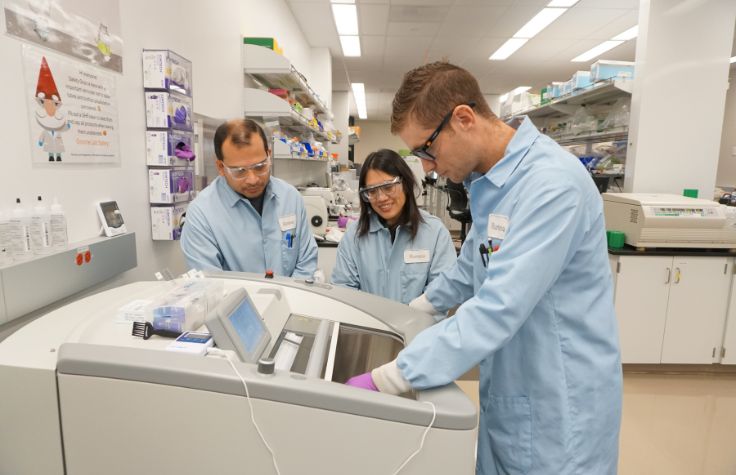
8 October 2025
Immunotherapy has changed how oncologists treat cutaneous melanomas—a common and aggressive form of skin cancer. Unfortunately, these therapies are less effective against rare melanomas, such as ocular, acral, and mucosal. Kasey Couts, PhD, is trying to figure out why that’s happening and investigating new ways to improve melanoma care.
“Immunotherapies called ‘checkpoint inhibitors’ work in about half of cutaneous melanomas,” says Couts, who codirects the CU Center for Rare Melanomas at the University of Colorado Anschutz Medical Campus. “We want to understand why they don’t work in the other half and why they work poorly in rare melanoma patients.”
To get these answers, Couts and her colleagues are leaning heavily into proteomics: the ability to study proteins at scale. Using the new Illumina Protein Prep assay, a discovery and screening solution for quantifying 9500 proteins, they are investigating how cutaneous and rare melanomas can generate different proteomic signatures. Once identified, these biomarkers could eventually lead to new diagnostics and therapies.
Lesser-known melanomas
While many people are aware of cutaneous melanoma—particularly those who live in sunny climates—the other varieties are somewhat obscure. Ocular melanomas are comparatively rare, comprising about 5% of all melanomas. Still, they are the most common form of primary eye cancer.
Acral melanomas happen on the palms, the soles, and underneath the fingernails. They represent about 3% of melanomas. Mucosal melanomas are the rarest, making up around 1%. These hit the sinuses, the nasal passages, the vaginal canal, and other mucous membranes.
In a perfect world, immunotherapies would effectively treat all varieties. These drugs inhibit the checkpoint proteins PD-1, found on immune cells, and PD-L1, expressed on tumor cells and some immune cells. Healthy cells use checkpoint proteins to prevent immune cells from killing them—but the proteins become an obstacle when a healthy cell turns cancerous. Checkpoint inhibitors work for around 50% of cutaneous melanoma patients, but that efficacy drops to around 15% in these rare cancers.
A wealth of patient samples
To find answers, the Couts lab is analyzing samples from both cutaneous and rare melanoma patients. The group has an incredible resource to use in their studies: a 20-year-old melanoma biorepository.
Each blood plasma sample has detailed information, including the type of melanoma, whether the patient received immunotherapy, whether the treatment was effective, and other key data. Using Illumina Protein Prep, the lab is quantifying the different circulating proteins in each sample.
Illumina Protein Prep has been an essential tool, allowing Couts to see the broader picture. Although the lab has used other proteomic technologies, they were limited to 92 proteins. Illumina Protein Prep can help them identify approximately 9500 proteins. This scale is tremendously useful, as Couts tries to dissect the mechanisms that are making these rare tumors resistant to immunotherapy.
“We are looking at what’s happening in the tumor cells, as well as the types of immune cells inside tumors and the overall tumor microenvironment,” she says. “Illumina Protein Prep is helping us broaden our analyses to systemically investigate circulating proteins and the different factors that could be impacting the immune response.”
The process is relatively straightforward. Researchers divide biorepository samples into different groups and compare the data between them, looking at samples with cutaneous or non-cutaneous melanomas. In one case, they analyzed a sample taken from a cutaneous melanoma patient before treatment, and compared it to one taken from a mucosal melanoma patient before treatment, to understand how their circulating proteomes differed. The team had early access to Illumina Connected Multiomics and was able to use it to sort through the Illumina Protein Prep data and determine which proteins are present in each sample.
“I’m not a programmer,” says Couts, “and the software is incredibly user friendly. I don’t need an extensive bioinformatics background to use it, which is really helpful.”
What they’re learning
The team is still crunching the data, but the early results have been intriguing. Compared to the earlier, smaller panel, they can now test an increased number of cytokines—inflammatory proteins that help regulate the immune response. They are delighted to see that so many are involved in the response to immunotherapy. Cytokine levels could indicate whether a patient is more or less likely to benefit from immunotherapy.
“We are getting a better snapshot of what these cytokines look like in regular cutaneous melanoma patients that respond, or don’t respond, to immunotherapy,” says Couts. “We’re also examining different groups and finding differential protein expression between rare and cutaneous melanomas.”
These studies are producing some unexpected results. Anti-PD-1 therapies work by binding and inhibiting the checkpoint protein PD-1 on immune system cells. Curiously, proteomic data from cutaneous melanoma patients showed increased circulating PD-1 levels while the patients were on treatment, whereas that increase did not happen in patients with rare melanomas.
“We’re not really sure why treating with an antibody against a protein would make that protein’s circulating levels go up,” says Couts. “It’s something we have to figure out.”
Ultimately, she believes these efforts could identify therapeutic targets, as well as biomarkers that could help determine—with a simple blood test—which patients are more likely to benefit from immunotherapy.
“We’re hoping the data can help us understand the mechanisms that determine why some patients benefit from immunotherapy and others do not,” says Couts. “Illumina Protein Prep gives us a broad view of the proteome, which is important for our work. Good biomarkers aren’t necessarily the molecules you expect to find. Having unbiased data that looks more at the total complement of proteins in a sample is going to help us identify biomarkers and learn more about the biology of these different cancers.”
Learn more about Kasey Couts and her team's melanoma research: In a new webinar, they'll discuss their early findings with multiomics and the impact they could have. Save your spot!


